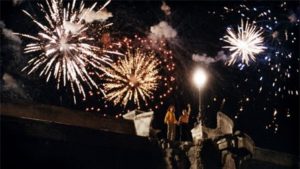STUDIO: Kino | DIRECTOR: Leos Carax | CAST: Juliette Binoche, Denis Lavant, Klaus-Michael Gruber, Marion Stalens
RELEASE DATE: 3/14/17 | PRICE: DVD $29.95, Blu-ray $34.95
BONUSES: video essay by Cristina Alvarez Lopez & Adrian Martin, print essay by Ignatiy Vishnevetsky
SPECS: R | 127 min. | Foreign language drama-romance | 1.66:1 widescreen | 2.0 stereo | French with English subtitles
Every fifth or sixth movie love story that is released gets hailed by some reviewer as “the most romantic movie in years.” The Lovers on the Bridge is indeed one of the most romantic movies ever made, and that is not simple hyperbole intended to sell a stiff, formulaic rom-com.
Lovers is also a genuine cult film, since it was a failure on it first release in 1991 and was distributed in a limited and disinterested way by its U.S. distributor, Miramax Films. In the years since, it has acquired a sterling reputation, thanks to word of mouth and the surprise success of its director’s last film, 2012’s Holy Motors (2012).
The plot is fable-like in its simplicity: an artist (Juliette Binoche, Mauvais Sang) losing her eyesight winds up alcoholic and homeless by choice. She takes up residence on the Pont Neuf bridge, where she is rejected by one homeless inhabitant, an old man (Klaus Michael Gruber), but is protected by another, an impish young man (Denis Lavant, Holy Motors) who falls in love with her. The two carry on a colorful and often perilous romance, but the artist’s loved ones continue to search for her to tell her a cure is available for her vision problem.
The film could’ve been as corny as hell, but Carax sets the characters up in a documentary fashion and then, once we know them well, he “unleashes” the magic produced by their love — represented by two tour de force set-pieces in which Binoche water-skis on the Seine (no stunt double here), and the couple dance on the bridge to a medley of various types of music, from classical to Iggy Pop and rap in a celebration of the 1989 Bicentennial of the French Revolution.
 The most remarkable thing about the film is the fact that, despite its set-pieces and seemingly grandiose production design, it is still a very “small” film at heart. Looking at it from this viewpoint it is fascinating to realize that Carax became a sort of pariah in French cinema after Lovers was released. This was due to the fact that the film took so long to shoot that the Pont Neuf — which had been closed for reconstruction when the film began — was reopened to the public, and Carax had to shoot the rest of the film on a copy of the bridge, built as a studio set. Critics and Carax’s fellow filmmakers were thus maliciously waiting to see the film fail at the French box office, since it represented an “ego gone wild.”
The most remarkable thing about the film is the fact that, despite its set-pieces and seemingly grandiose production design, it is still a very “small” film at heart. Looking at it from this viewpoint it is fascinating to realize that Carax became a sort of pariah in French cinema after Lovers was released. This was due to the fact that the film took so long to shoot that the Pont Neuf — which had been closed for reconstruction when the film began — was reopened to the public, and Carax had to shoot the rest of the film on a copy of the bridge, built as a studio set. Critics and Carax’s fellow filmmakers were thus maliciously waiting to see the film fail at the French box office, since it represented an “ego gone wild.”
The result is a love story that is sentimental but never cloying and has elements of suspense and comedy in amongst the drama. It also deftly references classic movie love stories, most prominently Chaplin’s City Lights (1931) and most cinephiles’ choice as the most romantic movie love story of all time, Jean Vigo’s L’Atalante (1934).
One of the primary reasons the film is so genuinely romantic is that at the time it was made Carax was in a relationship with Binoche, whom he had already transformed into a silent-movie-style goddess in his brilliant 1986 caper film Mauvais Sang. Binoche had starred in several films by ’91, but she had yet to achieve the international fame that accompanied her Oscar-winning turn in The English Patient (1996).
Binoche is exquisite throughout the film, but Carax’s “secret weapon” is Lavant (the star of four of Carax’s five films). While not conventionally good-looking, Lavant is incredibly charismatic onscreen and performs wonderful stunts throughout the picture, including walking the walls of the Paris Metro and eating fire.
One wishes that this beautiful restoration of the film was accompanied by vintage supplements of any kind. For interviews with those involved, one has to watch Mr. X, a Vision of Leos Carax, the documentary that was included in Kino’s two-disc release of Mauvais Sang.
What is included here is a lyrical visual essay by Cristina Alvarez Lopez and Adrian Martin, made for the MUBI website. Lopez and Martin focus on the film’s visual and thematic elements, noting the repetition of certain imagery and Carax’s approximation of Binoche’s character’s POV in the delirious water-skiing sequence.
A print essay by Ignatiy Vishnevetsky included in the set’s booklet also dotes on the film’s visuals and themes. The most interesting information imparted appears in two paragraphs in which he discusses the film’s genesis and prolonged shoot, as well as the aftermath of the initial theatrical release.
This set will hopefully create an even bigger cult following for the film, as it does get better with each viewing. Carax’s ambitious “folly” is indeed one of the finest love stories ever committed to celluloid.
|
Buy or Rent The Lovers on the Bridge
|
|---|
Leave a Reply